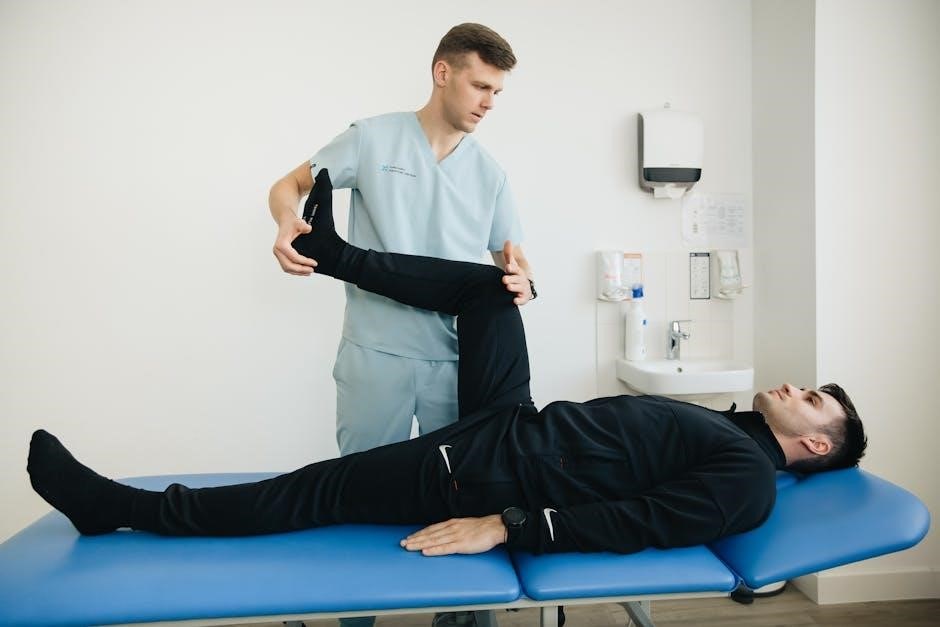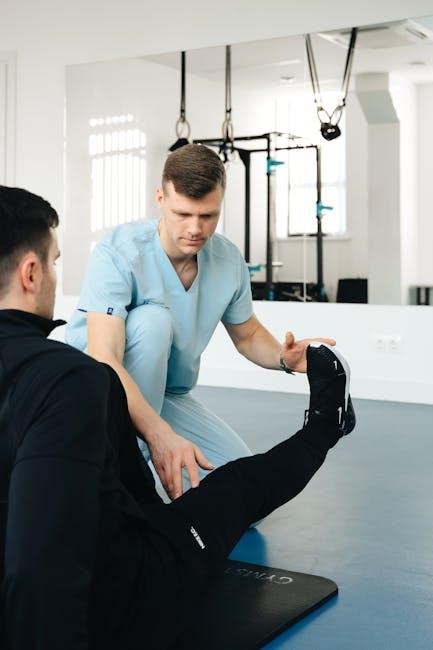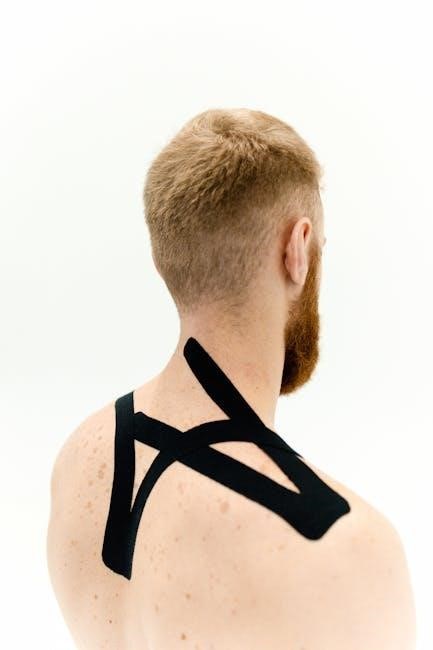Physiotherapeutic scoliosis exercises are designed to treat idiopathic scoliosis, with certified physiotherapists creating individualized programs, including postural exercises and 3D auto-correction techniques, to stabilize correct posture and prevent progression.
Understanding Scoliosis and its Treatment
Understanding scoliosis and its treatment is crucial for effective management of the condition. Scoliosis is a complex three-dimensional deformity of the spine, which can be caused by various factors, including genetic, environmental, and hormonal influences. The treatment of scoliosis has undergone significant changes over the years, with a shift from aggressive interventions to more conservative approaches. Physiotherapeutic exercises have emerged as a key component of scoliosis treatment, aiming to improve spinal mobility, strength, and posture. A comprehensive understanding of scoliosis and its treatment options is essential for healthcare professionals to develop individualized exercise programs that cater to the unique needs of each patient. By recognizing the importance of early intervention and ongoing management, patients with scoliosis can benefit from improved outcomes and enhanced quality of life. Effective treatment of scoliosis requires a multidisciplinary approach, involving physiotherapists, orthopedic specialists, and other healthcare professionals working together to provide comprehensive care.
Evolution of Scoliosis Treatment Over the Years
The treatment of scoliosis has undergone significant evolution over the years, with a shift from primarily surgical interventions to more conservative approaches. Historically, scoliosis was often left untreated until the condition had progressed to a severe stage, at which point surgical intervention was often necessary. However, with advances in medical understanding and technology, the focus has shifted to early intervention and prevention of progression. The development of bracing and physiotherapeutic exercises has provided alternative treatment options, reducing the need for surgical intervention. Additionally, improvements in imaging technologies have enabled earlier diagnosis and more accurate monitoring of the condition. As a result, patients with scoliosis now have access to a range of treatment options, and healthcare professionals can work with them to develop personalized treatment plans. This evolution in treatment approaches has improved outcomes for patients with scoliosis, enabling them to manage their condition and maintain a high quality of life. Effective management of scoliosis requires ongoing monitoring and adaptation of treatment plans.

Physiotherapeutic Scoliosis Specific Exercises (PSSE)
PSSE involves individualized programs, curve pattern specific exercises, and 3D auto-correction techniques, designed by certified physiotherapists to treat scoliosis, with a focus on stabilizing correct posture and preventing progression effectively always.
Definition and Purpose of PSSE
The definition of Physiotherapeutic Scoliosis Specific Exercises (PSSE) refers to a set of exercises designed to treat scoliosis, with the primary purpose of preventing progression and stabilizing the spine. These exercises are individualized, taking into account the specific curve pattern and needs of each patient. The purpose of PSSE is to improve posture, reduce pain, and enhance overall quality of life for individuals with scoliosis. By focusing on 3D auto-correction techniques, PSSE aims to address the complex nature of scoliosis, which involves not only lateral curvature but also rotation and sagittal imbalance. The goal of PSSE is to empower patients with the knowledge and skills necessary to manage their condition effectively, reducing the risk of secondary problems and promoting long-term spinal health. With a thorough understanding of the definition and purpose of PSSE, patients can work closely with certified physiotherapists to develop a personalized exercise program that meets their unique needs and goals. This collaborative approach is essential for achieving optimal outcomes and improving overall well-being. PSSE is a valuable treatment option for individuals with scoliosis, offering a non-invasive and effective way to manage the condition.
Curve Pattern Specific Exercises and 3D Auto-Correction
Curve pattern specific exercises are a crucial component of Physiotherapeutic Scoliosis Specific Exercises (PSSE), as they are tailored to address the unique characteristics of each patient’s spinal curvature. These exercises are designed to target specific muscle groups and movement patterns, with the goal of correcting the curve and improving posture. The 3D auto-correction technique is a key aspect of PSSE, as it involves training patients to auto-correct their spinal alignment in three dimensions. This approach takes into account the complex nature of scoliosis, which involves not only lateral curvature but also rotation and sagittal imbalance. By focusing on curve pattern specific exercises and 3D auto-correction, patients can learn to stabilize their spine and prevent further progression of the curve. This approach requires a thorough understanding of the patient’s curve pattern and a personalized exercise program, which can be developed in collaboration with a certified physiotherapist. The exercises are designed to be progressive and adaptable, allowing patients to continue challenging themselves and making progress over time.

Benefits of Scoliosis Specific Exercises
Exercises prevent scoliosis progression, improve posture, and enhance overall spinal stability and function naturally.
Preventing Progression of Idiopathic Scoliosis
Preventing the progression of idiopathic scoliosis is a primary goal of scoliosis physiotherapy exercises. According to recent studies, exercises can help prevent the curvature of the spine from worsening. A well-structured exercise program can improve spinal stability and reduce the risk of progression. The exercises are designed to strengthen the muscles that support the spine, improve posture, and enhance overall spinal function. By preventing progression, individuals with idiopathic scoliosis can avoid more invasive treatments, such as bracing or surgery. The exercises are typically tailored to the individual’s specific needs and curve pattern, and are usually performed under the guidance of a certified physiotherapist. With consistent practice and dedication, individuals with idiopathic scoliosis can effectively manage their condition and prevent further progression, improving their overall quality of life and reducing the risk of long-term complications. Regular exercise and physiotherapy can make a significant difference in the management of idiopathic scoliosis.
Importance of Certified Physiotherapists

Certified physiotherapists play a crucial role in the management of scoliosis through physiotherapy exercises. They have the necessary expertise and knowledge to design and implement individualized exercise programs that cater to the specific needs of each patient. Certified physiotherapists are trained to assess the patient’s curve pattern, spinal flexibility, and muscle strength, and develop a tailored exercise program to address these factors. They also provide guidance on proper posture, breathing techniques, and body mechanics to help patients manage their condition effectively. Moreover, certified physiotherapists can monitor the patient’s progress, adjust the exercise program as needed, and provide ongoing support and education to ensure optimal outcomes. By working with a certified physiotherapist, individuals with scoliosis can benefit from a comprehensive and personalized approach to management, which can lead to improved spinal stability, reduced pain, and enhanced overall well-being. This specialized care can make a significant difference in the long-term management of scoliosis, and certified physiotherapists are essential in providing this care. They are the key to unlocking the full potential of scoliosis physiotherapy exercises.

Exercises for Scoliosis Management
Exercises for scoliosis management include pelvic tilts, postural corrections, and breathing techniques, designed to stabilize the spine and improve posture, with certified physiotherapists guiding patients through individualized programs.
Postural Exercises and Their Significance
Postural exercises are a crucial component of scoliosis physiotherapy, aiming to improve spinal alignment and reduce curvature. These exercises focus on strengthening the muscles that support the spine, enhancing flexibility, and promoting good posture. By incorporating postural exercises into their daily routine, individuals with scoliosis can experience significant improvements in their overall spinal health. The significance of postural exercises lies in their ability to stabilize the spine, reduce pain, and prevent further curvature progression. Certified physiotherapists play a vital role in designing personalized postural exercise programs, taking into account the individual’s specific curve pattern and needs. Through consistent practice and dedication, postural exercises can become an essential tool in managing scoliosis and improving quality of life. By combining postural exercises with other forms of physiotherapy, individuals with scoliosis can achieve optimal results and maintain a healthy, stable spine. Regular practice of postural exercises can lead to noticeable improvements in spinal alignment and overall well-being.
Sample Exercises for Scoliosis Patients
Sample exercises for scoliosis patients include pelvic tilt exercises, which involve lying on the back with knees bent and tilting the pelvis upwards and downwards. Other exercises include shoulder rolls, chest expansions, and spinal extensions. These exercises are designed to be held for a count of 5 and repeated 10 times, once or twice daily. It is essential to only perform exercises that have been specifically recommended by a certified physiotherapist. Exercises such as backlying with knees bent, and breathing exercises can help improve spinal alignment and reduce curvature. Patients are advised to keep their shoulders flat on the floor and breathe regularly while performing these exercises. By following a personalized exercise program, scoliosis patients can experience significant improvements in their spinal health and overall well-being. Regular practice of these exercises can help stabilize the spine, reduce pain, and prevent further curvature progression. A certified physiotherapist can provide guidance on the most effective exercises for each individual patient.
